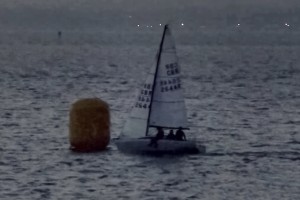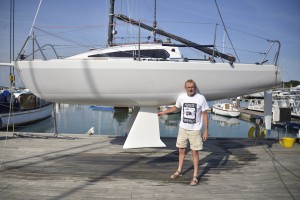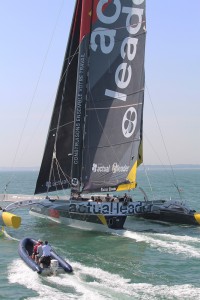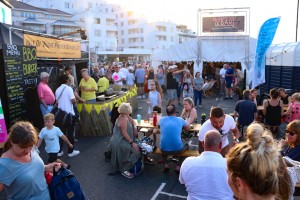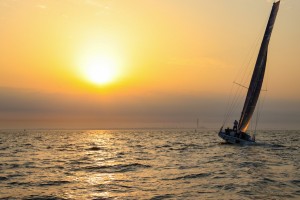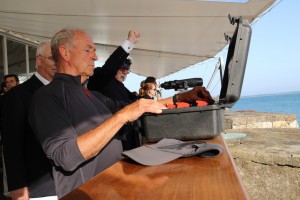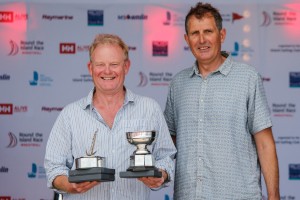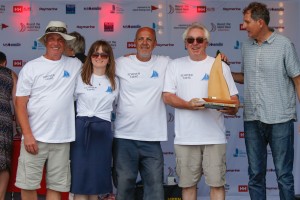An 18 foot Cowes-based twin keeler Eeyore, won the prestigious Gold Roman Bowl, the most sought-after prize, in this year’s Round the Island Race, after a long tactical day on the water.
With a crew of just three: skipper Jo Richards and his friends David Rickard and Duncan De Boltz, sailed the modified 1964 Alacrity 18 which, at 18ft 6in overall, was the smallest boat in the race. A member of Gurnard Sailing Club and Cowes Corinthian, Richards said:
“It was an interesting but long race, we actually started at the opposite end of the line from the rest of the fleet which paid us reasonably well in the end. We got down to The Needles in the middle of the fleet and then there was almost no wind. We bounced off a couple of rocks on The Needles just for good measure and then it’s tempting to stay out of the tide, so we did a couple of little tacks and thought: no we need to be strong-minded and go out, because you always get a wind bend down off Freshwater and if you sail along under the cliffs it just leaves you in a hole.
The race offered challenging sailing conditions for the crew of Eeyore, which circumnavigated the Isle of Wight in 13 hours, 36 minutes and 31 seconds. The fleet of over 1,200 entries contended with fluctuating wind speeds from every direction, with only 257 boats completing the race before the 10.30pm deadline.
After competing in the Round the Island Race more times than he can remember and with two second places already under his belt, Richards continued: ”It’s probably about time too isn’t it? We’ve been second a couple of times over the years but the reality is there are some very good sailors out there and very good boats; you’ve got to be lucky and get the breaks. Unless you’ve done the preparation and put yourself in a position to get the breaks it doesn’t happen, but you do still have to be lucky.”
Jo, who won Olympic Bronze in 1984 with Peter Allam in the Flying Dutchman is best known for his dinghy designs (Laser Pico, Bahia, Vago, Bug, RS Aero et al). He modified Eeyore after he found her in a dilapidated condition three years ago. “She was full of oil, peeling paint and in a very gloomy situation, hence the name,” he said. “Initially I thought she was a 20ft Vivacity – five of us used to cruise one as a family, and though I paid nothing I bought her as such. But she turned out to be the shorter model, the Alacrity, though they look the same.
“The deck was falling in so I used another deck that I happened to have hanging in my design workshop and for the first two seasons I removed the bilge keels and put a fin on her. But over the last winter we went back to bilge keels, using some made to my own design that were cast for me by Irons Brothers in Wadebridge. They are not like the originals, no! The technical term is negative sweep back but the best way to explain it is that the bottom of the leading edge is about 15 inches forward of where the keel attaches to the hull. That’s because I wanted the root of the keel as far back as possible, to where the water runs parallel to the centreline. But then they have to sweep forward to maintain the balance. Nobody’s really thought of bilge keels for 50 years and we are certainly the first bilge keeler to win this race. We got the mast from the Selden scrap bin (off a RS Elite), also a National 18 boom and the rudder is from a broken Laser SB3. It didn’t cost money, but we did put in a lot of time. The only downside is the odd lobster pot and we do have a good weedstick which has been used a few times.”
Jo is now hoping for a good result at Cowes week, though he lamented the lack of small craft being raced: “There used to be 50 boats in Class 7 and now there are ten. Things are getting worse for the small boats, which is a shame.”
And the others…
The first finisher (with a time of 7 hours, 33 minutes and 36 seconds) was Yves Le Blevec’s Grand Prix racing multihull – Actual Leader which led for much of the race. In light to moderate winds she managed to shake off her closest on-the-water rivals – Jethou, Ino XXX, Lady Mariposa and Mini Y.
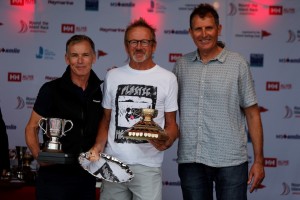
Jo Richards centre, with crew Duncan de Boltz, left receives his prize from Record-breaking British Sailor Brian Thompson, right. © Paul Wyeth
A delighted Le Blevec (53) from La Trinité Sur Mer, commenting on a long, but exciting day on the racecourse just before he set sail back to France, said: “I really enjoyed the race, I always enjoy sailing here and it was great to have taken line honours. This is now my fourth time competing here but in this boat it was tricky. We stayed in the same place for two or three hours off Ventnor in no wind, which was frustrating. ‘Actual’ is designed as a round the world boat not for Round the Island Race. It is very difficult to manage tacking or gybing so often, so we are pleased to have done so well today.”
The award for the first monohull across the line, at 16:30:28 (taking 9 hours and 28 seconds), went to Sir Peter Ogden’s Judel Vrolijk Mini Maxi Jethou which almost snatched the lead from Actual Leader earlier in the day. Despite hitting the bottom and hooking a lobster pot the crew of Jethou had a great race with owner, Sir Peter Ogden, commenting: “Our top speed was 20knts which was 2 minutes after the start, but it went downhill after that and we averaged 7.9knts over the course. The best sail of the day was the stretch from the forts to the finish where we enjoyed a really nice breeze.”
This year’s race saw thousands of sailors compete on over 1,200 yachts in one of the UK’s largest sporting events. The Round the Island Race is a true race for all with competitors enjoying a spinnaker start for the first time in almost ten years.
Many yachts did not finish and of the 26 yachts that registered in the Classic Racing Yachts Division for instance, only three (Flyover, Eager and Quailo III), managed to get a finishing time.
Commodore of the Island Sailing Club, David Atkinson said: “It was a difficult day, we started in such great conditions in the morning with the wind doing exactly what we thought it would but as the day progressed the wind became increasingly unpredictable. One example was at St Catherine’s Point where one side there was 15knts of breeze, but just around the corner, half a mile away only 5-6knts of breeze from a totally different direction. Tactically today it was difficult because the wind was all over the show.
“But the competitors have been terrific, with lots of feedback on what a lovely day people have had on the water despite the wind. Someone said to me anyone can sail in a reasonably good, steady breeze but when you have to tactically think about the wind, the tides and everything else in order to make your boat go, that can make it really interesting.
“I’d like to thank all the competitors for making this a fantastic event, the new Official Race Village (see more: HERE) has gone down well and had a real buzz around it and now we’re looking forward to the prize giving tomorrow and welcoming people back again next year on 30th May 2020.”
British Sailing Team and official Round the Island Race Meteorologist, Simon Rowell, commented: “The weather today was set up for a good quick run down to The Needles, then once the fleet got through The Needles they were beating back up to St Catherine’s Point, still in a reasonable amount of breeze so that worked out OK.
“Then in the very hot afternoon, the warm air bubbling up off the island killed the breeze for quite a long way offshore, going from St Cat’s round to Bembridge. With some filling in, it did go round to the right as we were expecting with the forecast, and its now coming in nicely from the west southwest; but there was a very slow 3 or 4 hours for quite a few boats going round the south east side of the Isle of Wight. The boats that did really well, especially the winner, managed to catch it very well and were just ahead of the light stuff on the south east of the Island and managed to have a good run right to the finish.”
Michael Kitchen, actor, television producer and competitor, was the official race starter of the 88th Round the Island Race, at the Royal Yacht Squadron (left). Known particularly for his role as Detective Chief Superintendent Christopher Foyle in the ITV drama series Foyle’s War he said: “I couldn’t feel more honoured with the invitation of the official starter of this iconic race. It is a huge privilege. I have competed at the event many times and we always have a cracking time. It is a brilliant event.”
The Round the Island Race is sponsored by Helly Hansen, Raymarine and MS Amlin
Results
Trophies presented included:
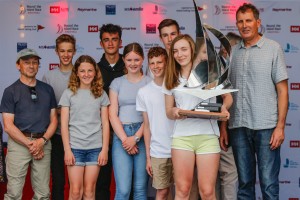
Young sailors on Embley won RAYMARINE’s RTI YOUNG SAILOR TROPHY (ISCRS) and the ISC Rating System Division 7A © Paul Wyeth
Line Honour Prizes
Observer Trophy (1st monohull): Jethou, GBR74R, Sir Peter Ogden
Conrad Ritblat Trophy (1st IRC Class): Jethou, GBR74R, Sir Peter Ogden
Helly Hansen Trophy (1st ISCRS Class): Panther, GBR6690R, James Stableford
Freedom Challenge Bowl (1st multihull): Actual Leader, 53, Yves Le Blevec
IRC Rated Classes
Gold Roman Bowl & Salver (1st IRC on corrected time): Eeyore, GBR2644R, Jo Richards
Silver Roman Bowl (2nd IRC on corrected time): Ziggy, GBR4069T, Kevin Downer
Special Race Trophies
Tenacity Trophy: ZARA, Andy Young
Click here for the full 2019 race results



